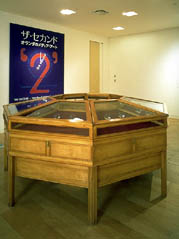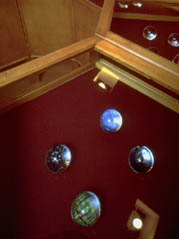

|
| Technical Details: show case,
8 x 4 glass bullets, 8 monitors, 32 prisms, 1 push button |
|
Is it possible to see the future in the present? An impossible question which immediately subsides into the next question: but what is the present? Is it an unambiguous, well-ordered and universally valid whole, or a dynamic mosaic of images and events, which we can hardly get a grip on? The latter would seem to be more true of our time, in which, via the media, we have an endless deluge of information at our disposal. However, this information is also extremely incomplete, fragmentary, and changeable. We seem to have gained more insight than ever into the present, which has never been so great before, but at the same time we are losing our grip on it, and it becomes increasingly difficult for us to understand what is really happening.
Jaap de Jonge's Kristallen Bol (Crystal Ball) is an interactive object which, on the viewer's touch, shows a kaleidoscopic image. This is an image composed from various sources: television images projected onto the glass ball and mixed with computer-generated patterns and animations. In an interplay with the movement on the TV images, an abstract and fragmented image emerges, which is constantly changing. When you touch the ball, it changes channels, and in consequence, so do the images and sounds.
What kind of future does Kristallen Bol foretell? Indeed, as viewer, you cannot
trace the origin of the images, while their message, what they have to tell
us, has been made unintelligible in the interest of an aesthetic and lively
pattern of colours and shapes. Moreover, while your touch can influence the
ball, you cannot control it. Kristallen Bol is prophetic, but in the sense that
it shows us the present as the future, and that it illustrates our problematic
position in this present.
De Jonge's O.T.S. (the initials of the Dutch for Public Television Sculpture), features the crystal ball once again. De Jonge has placed as many as 28 of these balls in a free-standing, octangular, old-fashioned museum show case, which is made of wood and glass and divided into a number of compartments which you can look into from above. 'Touch me' does not apply here: the magic balls are displayed and protected as traditional museum pieces.
You see constantly changing images, which are more or less 'intelligible'. What is perfectly clear is that these are not the usual, mainstream, television images. These are about art. De Jonge used broadcasts made by Dutch artists for P.A.R.K. 4DTV, split each image from a single video source into four and distributed it over four different balls.
With O.T.S., De Jonge reversed a number of conventional art codes and presentation methods, by explicitly placing TV images (of art) in a museum context, by filling 'his' work of art with that of others, which he subsequently entrusted with his own form. He brings the values of museum reality and those of the electronic present together in a single space, to demonstrate, as it were, the relativity of both systems. The crystal balls in O.T.S. seem to foretell something other than in Kristallen Bol, namely, the condition and future of art.
For this sculpture Jaap de Jonge made use of 32 different videoworks produced by 32 artists. These works are a selection of over 500 cablecasts of PARK 4.D.T.V., each night on Amsterdam Cable from 01.00 to 02.00 a.m.
The artists are:
Bill Spinhoven, Maarten Sprenger, Chiel Snijders, D'Orazio Verheggen, Max Kisman, Harvey Oswald, Gerald van der Kaap, Lonnie van Brummelen, Maarten Ploeg, Arnold Weel, Joke Mesdag, A. Kopper, Ryu Tajiri, Adriaan Nette, Peter Mertens, Henk Wijnen, Safy, Wiel Seuskens, Jaap de Jonge, Danielle Kwaaitaal, Jop Horst, Coen Pausma, Pieter Baan Mller, Dick Tuinder, Peter Spaans, Pépé Smit, Jeroen Kooijmans, Nirit Peled, Fiona Tan, Hans Eikelboom, Harco Haagsma, Linda van Boven.
Jorinde Seijdel
|
|
